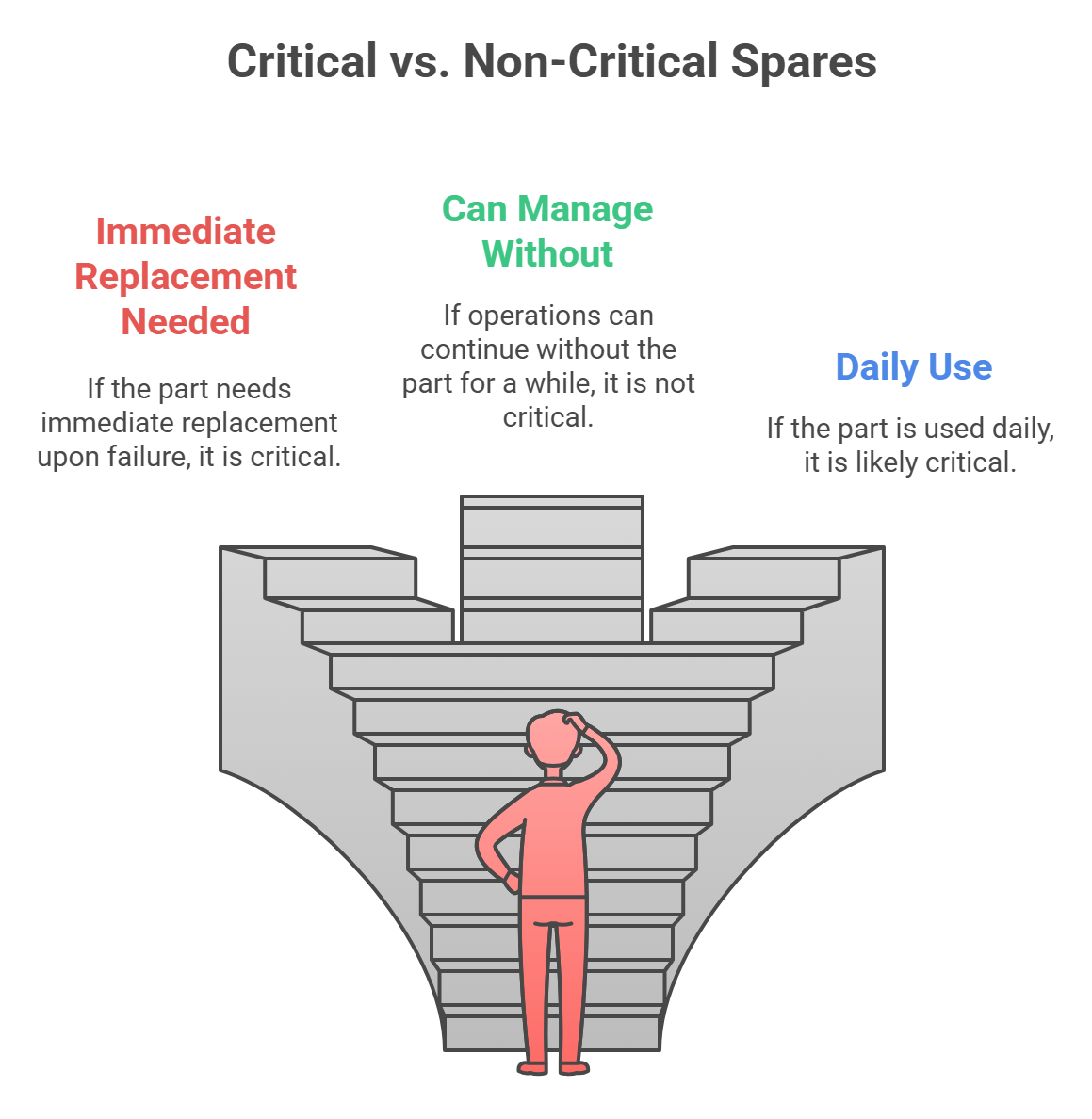
Successful parts inventory management involves a lot of careful balance, especially when it comes to critical spares. On one hand, keeping too many component parts around can be expensive, both in terms of money and space. Most operations can’t afford to keep a backup of every part they’ll ever need in the warehouse.
Wenn Sie andererseits keine kritischen Teile auf Lager haben, ist die Wahrscheinlichkeit ungeplanter Ausfallzeiten oder Sicherheitsrisiken viel größer. Sie können es sich nicht leisten, die Produktion jedes Mal zu stoppen, wenn ein wichtiges Teil verschlissen ist, vor allem wenn man die Realität der heutigen Lieferkettenprobleme bedenkt.
Wie können Sie also entscheiden, welche Anlagenkomponenten Sie auf Lager halten sollten? In diesem Artikel zeigen wir Ihnen, wie Sie die Kritikalität von Ersatzteilen beurteilen können. Außerdem erfahren Sie, wie sich die Kritikalität in eine proaktive Wartungsstrategie einfügt.
Was sind kritische Ersatzteile?
Critical spares are the components that your operation must have in order to stay up and running. Without these parts, your production line will break down, and you won’t be able to meet deadlines or deliver products.

Most of the time, critical spare parts refer to the components that are necessary for your key production equipment. However, in many cases, your maintenance tools for these parts are also critical. Critical spare parts management includes responsible management of maintenance tools and parts, as well as any important components that are custom-made or that take a long time to ship.
Not sure whether a particular part is critical? Ask yourself: If that part fails, how quickly will you need to replace it? If the answer is right away, then it’s a critical part.
Wenn Sie aber eine Zeit lang gut ohne sie auskommen, ist es nicht so wichtig.
Überlegen Sie auch, wie oft Sie ein bestimmtes Gerät benutzen. Wenn Sie sich täglich auf einige Ihrer Geräte verlassen, sind diese wahrscheinlich kritisch, auch wenn sie nicht Teil Ihrer Produktionslinie sind.
Talk to your teams and get their views on which equipment is most important. That’s the first step to carrying out an Asset CriticalityAssessment (ACA).
Durchführen einer Bewertung der Kritikalität von Ersatzteilen
Typically, team members will all have different ideas of which parts are most critical. If you haven’t already done an ACA, also called a spare part assessment, you should run one as soon as possible. Talk to everyone involved and get detailed reporting on the assets that they identify as critical. Computerized Maintenance Management System (CMMS) software is also a valuable tool in assessing asset criticality.
Sobald Sie festgestellt haben, welche Anlagen für Ihren Betrieb am wichtigsten sind, müssen Sie sicherstellen, dass Sie die wichtigen Teile für diese Anlagen auf Lager haben.
The Benefits of Effective Criticality Assessments and Critical Spares Management
These are the key factors that show why critical spare parts management matters for your core operations.
Avoid Costly Downtime
Keeping critical spares on hand means you’ll see a drastic reduction in unplanned downtime. You won’t be caught off guard when a motor suddenly stops running or when a fan breaks down, because you’ll have a backup part in your storeroom. As a result, you’ll keep your plant running longer and avoid excess costs from unplanned downtime.
Reduce Costs for Parts and Shipping
You’ll also likely pay lower shipping costs and may even pay less for each spare part. Planning ahead means you’ll avoid expensive rush shipping and be able to look around for the best prices available.
Improve Inventory Levels
Of course, figuring out which spares are critical can also help you make better use of your storage space. Once you determine which parts are critical, you can eliminate many of the non-essential parts from your warehouses. That means that your storage spaces will be leaner, better organized, and easier to navigate.
Enhance Operational Efficiency
With the right parts in stock, you’ll also reduce lead times to enable more efficient maintenance planning and execution. Effective parts inventory management also helps strengthen relationships with your suppliers, which, in turn, can improve your critical spare management. As a loyal customer, you’ll likely be the first to know when supply chain disruptions occur.
Plus, predictive maintenance technologies can help identify potential failures that, if left unchecked, could lead to costly downtime, production delays, and extensive repairs. This alerts your team to restock those repair parts.
Was ist der Unterschied zwischen kritischen und strategischen Teilen?
Teams must keep critical spares on hand to prevent immediate downtime or safety risks. But many organizations also stock strategic spare parts to reduce risks such as long lead times, obsolescence, or sourcing challenges. Both strategic and critical spares are important, but they serve different purposes.
Unlike critical spare parts, strategic spare parts address issues that might not stop operations immediately but could compromise long-term asset functionality or lifespan. The goal of keeping strategic parts on-hand is to maximize an organization’s ability to maintain and support its assets over time, so technicians can continue to maintain assets without replacing them.
Häufige Gründe für die Aufbewahrung strategischer Ersatzteile in einem Lager sind unter anderem:
- Veralterung: Mit zunehmendem Alter der Geräte wird es immer schwieriger, Ersatzteile zu finden. Ein strategischer Bestand an Ersatzteilen hilft sicherzustellen, dass immer die richtigen Teile zur Verfügung stehen.
- Long lead times: If a part takes an unusually long time to procure, keeping a small inventory of parts can help minimize downtime.
- Herausforderungen bei der Beschaffung: Bei Unterbrechungen der globalen Lieferkette oder bei Problemen mit der Zuverlässigkeit der Lieferanten kann es schwierig werden, bestimmte Teile zu beschaffen. Ein strategischer Lagerbestand hilft, das Risiko zu verringern, dass Anlagen aufgrund nicht verfügbarer Komponenten irreparabel werden.
Whether you’re managing critical or strategic spare parts, following best practices enables you to support operational continuity and reliability with your spare parts management strategy.
What Is the Difference Between Insurance Spares and Critical Spares?
Insurance spares are a subset of strategic parts. These are parts that a facility doesn’t expect to equip for an asset’s normal functions; they’re very rarely needed. However, if these parts aren’t available during a critical equipment failure, it would lead to excessive, costly downtime with major revenue loss.
These spares are often expensive and come with long lead times. So, if you wait to order them until an equipment failure occurs, it compounds the impact to budget and time.
These parts are called insurance spares because having them on hand is a form of insurance against significant potential loss.
What Are Four Types of Spare Parts?
Apart from classifying specific parts as critical versus non-critical, there are other types of parts you can order.
Original Equipment Manufacturer (OEM) parts are those produced by the manufacturer of your asset. They may be among the most expensive, as they’re typically high-quality and very reliable. However, since the original manufacturer designs and produces them, they’re also the most likely to match your asset perfectly. Most notably, OEM parts won’t void your equipment warranty.
Aftermarket parts come from a third-party manufacturer. They’re less expensive compared to OEM parts, but many good-quality aftermarket parts feature premium engineering to match OEM specifications. It’s important to research the quality and durability of these parts. Also, some aftermarket parts may void your asset warranty.
Remanufactured parts are non-new parts that have been refurbished to function like new. They’re cheaper than OEM parts but have a more limited lifespan. Remanufactured parts may not be available for all equipment types, and not all parts are available as remanufactured parts.
Finally, used parts are non-new parts that have operated in equipment previously but have not been refurbished. This makes them very inexpensive. However, due to their wear and lack of refurbishment, the functionality and useful lifespan of these parts is unreliable. Employ used parts sparingly and cautiously — never for high-risk or safety components.
How To Adopt a Critical Spare Parts Inventory Strategy
Once you’re ready to implement this inventory management approach, here are some of the first steps you should take:
- Conduct your asset criticality assessment. Start by classifying parts as critical or non-critical.
- Modify your maintenance strategies. Forward-thinking strategies such as predictive maintenance, preventive maintenance, and Condition-Based Maintenance (CBM) improve accuracy in maintenance planning and inventory levels.
- Revise your orders for lower-demand spares. Check ordering frequency and inventory levels for non-critical items at your organization and adjust accordingly, so you can free up space for critical items.
- Adjust budget allocation for critical spares. Auditing procurement for non-critical spares should allow you to reallocate new funds for essential parts.
- Order sufficient critical spares. Now that you know which parts are critical, it’s time to put in the appropriate orders to get your inventory levels to where they need to be.
- Monitor asset performance with essential metrics. Use calculations such as Mean Time Between Failures (MTBF) and Mean Time to Repair (MTTR) to make data-driven decisions.
Learn more about the seven most important maintenance metrics.
This balance of assessments, strategies, inventory management, and asset performance monitoring ensures an efficient and effective approach to implementation.
Bewährte Praktiken für das Management kritischer Ersatzteile
Die Einführung einiger wichtiger Praktiken kann Ihr kritisches Ersatzteilmanagementsystem verändern. Hier sind einige der besten Strategien.
Effektive Prioritäten setzen
Assess how often your critical spare parts need to be replaced. Start by carrying out an asset criticality analysis or conduct a new one if it’s been a while since the last ACA. Studying your work order history will also give you more insights into each asset’s maintenance needs.
Bei der Bestellung und Bevorratung von Teilen sollten Sie den kritischen Ersatzteilen, die häufig ersetzt werden müssen, Priorität einräumen. Konzentrieren Sie sich auch auf die Beschaffung von Teilen mit langen Vorlaufzeiten, damit Sie nicht durch unerwartete Lieferverzögerungen überrascht werden.
Verwenden Sie ein effektives System zur Verfolgung kritischer Ersatzteile
Use a cloud-based tool to track the location of your critical spares, especially if your team has multiple warehouses or facilities. Look for a tool that can also track when parts were last ordered and when they need to be reordered. It’s a good idea to use QR codes or RFID tags that you can scan to automatically update inventory.
Standardize inventory processes so that all of your inventory is tagged and scanned upon arrival in the warehouse. This will require some additional training and supervision at the outset, but it will pay off quickly. Systematic tagging and scanning mean you’ll be able to easily locate every piece of inventory in your organization across all of your facilities.
Einführung einer proaktiven Wartungsstrategie
Mit der proaktiven Wartung verlassen Sie den reaktiven Modus und erhalten datengestützte Erkenntnisse zur Verbesserung der Wartungs- und Bestandsplanung.
Approaches like preventive maintenance and predictive maintenance extend the lifespan of your assets and reduce unexpected downtime at your facilities. As a result, you won’t face sudden, unexpected breakdowns that leave you scrambling for spare parts.
Discover how the right EAM solution can cut downtime and help you stay proactive.
Kritische Ersatzteile und proaktive Wartung
Mit einer proaktiven Wartungsstrategie können Sie sicherstellen, dass Sie immer die benötigten Ersatzteile auf Lager haben. Proaktive Wartung bedeutet, dass Sie dem Ausfall Ihrer Anlagen immer ein paar Schritte voraus sind, indem Sie den Zustand Ihrer Anlagen im Auge behalten. Wenn Sie Ihre Anlagen auf frühe Anzeichen von Defekten überwachen, wissen Sie immer rechtzeitig, wann ein Teil ersetzt oder repariert werden muss.
This can be as simple as having your crews carry out route-based vibration monitoring on a regular basis. Changes in vibration patterns sometimes indicate new machine faults. The sooner you discover those faults, the sooner you can order the parts you need to fix them.
Sie könnten auch ein Schwingungsüberwachungssystem mit drahtlosen Schwingungswächtern und einem CMMS aufbauen. Schwingungswächter sammeln kontinuierlich Schwingungsdaten, so dass Ihnen keine wichtigen Informationen entgehen. Und Sie können Ihr CMMS so konfigurieren, dass es automatisch einen Arbeitsauftrag erstellt, sobald die Schwingungswerte Ihre Parameter überschreiten.
How To Prepare for Critical Spare Parts Shortages
Engpässe in der Lieferkette sind eine Tatsache, und das wird sich wohl auch nicht ändern. Zum Glück kann eine sorgfältige Planung dazu beitragen, die Auswirkungen von Engpässen und Preiserhöhungen abzufedern. Hier erfahren Sie, wie Sie Ihr Endergebnis schützen können.
Verbessern Sie Ihre Vorhersagefähigkeiten
Stock up ahead of time on critical parts so that sudden shortages don’t impact production as much as normal. Use historical data analytics to predict when you’re likely to need more parts and order ahead of time. Work order history can tell you how often parts need to be replaced; inventory tracking can tell you how many parts you have remaining.
Analyse der Durchlaufzeit
Wenn Sie mit langen Vorlaufzeiten konfrontiert sind, sollten Sie eine Analyse durchführen, um genau zu ermitteln, wo die Engpässe liegen. Versuchen Sie, die folgenden Fragen zu stellen:
- Bestellt Ihr Team die Teile rechtzeitig nach, oder kommt es zu Verzögerungen im Prozess?
- Entladen Sie die Aufträge zeitnah und verfolgen Sie den Standort jeder neuen Sendung?
- Wenn sich der Versand verzögert, können Sie herausfinden, welcher Lieferant die Verzögerung verursacht?
Die Ermittlung der Problemquelle kann Ihnen helfen, das Problem zu beheben und zu lösen.
Dual-Source Ihre Lieferanten
Don’t rely on just one supplier to provide critical spares. Instead, diversify as much as possible. Using multiple suppliers means that if there’s a problem with one of your vendors, you can pivot to another supplier, saving you from potential headaches.
Erhöhen Sie die Genauigkeit Ihres kritischen Ersatzteilbestands
Wenn Ihr Lagerbestand unbekannt oder ungenau ist, ist es schwierig, Engpässe zu vermeiden. Bauen Sie ein zuverlässiges Nachverfolgungssystem auf, damit Sie immer wissen, was Sie auf Lager haben und was Sie brauchen. Werkzeuge wie ein CMMS können dabei helfen. Auf diese Weise können Sie vorausschauend planen und teure Bestellvorgänge vermeiden, wie z. B. das Versenden von Teilen oder teure Ausfallzeiten, während Sie auf eine Ersatzteillieferung warten.
Solving Three Common Critical Spare Parts Challenges With a CMMS
A good CMMS can help you address the most common headaches associated with inventory management. Here’s how.
1. Fragen der Lieferkette
CMMS software delivers data-driven insights into asset health, so you have plenty of time to plan ahead for maintenance work. Accurate condition forecasting allows you to order parts well ahead of time, protecting you from last-minute supply chain hiccups. A good CMMS will even automatically prompt you to reorder parts when you run low.
2. Langsam drehende Teile
Slow-moving parts are components that have been sitting unused in your inventory for an extended period of time. They take up space that you could use for other, more critical spare parts. If they sit too long, slow-moving parts become obsolete.
A CMMS can analyze your past inventory orders, replacement rates, and time-in-inventory to help identify and manage slow-moving parts. You can even use a CMMS to create a warning system, so that maintenance team members get an alert whenever there’s an excess of slow-moving parts.
3. Globale gemeinsame Nutzung von Teilen über Standorte hinweg
A CMMS acts as a central repository for all of your inventory data — an invaluable resource when your organization manages multiple worksites.
A CMMS lets you see exactly where all of your parts are. If one of your worksites suddenly needs a replacement component, it may be easier or cheaper to ship those parts from one of your other facilities instead of paying for expedited shipping from a supplier.
Zusammenarbeit mit den Experten
Shifting to a proactive maintenance approach can do wonders for your whole operation. It makes inventory management much easier, especially when it comes to critical spares and determining asset criticality. For some companies, it can also lead to major savings, like reducing more than $1 million in spare parts inventory. Ultimately, proactive maintenance can boost productivity, and minimize downtime. But making this shift isn’t always easy. If you’re operating with a lean workforce, you may face special challenges.
The Fluke Reliability team of experts is available to help your operation with anything and everything related to proactive maintenance. We help you set up and maintain a vibration monitoring program through a one-time consultation or long-term monitoring assistance. Whatever level of support you need, the Fluke Reliability team can help.
Contact our team to learn more about our expert proactive maintenance services and tools.


